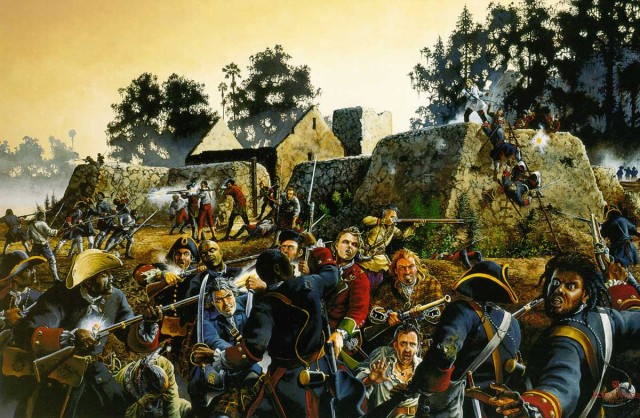Hidden away in the marshes of North Florida is one of the most important sites in American history. Its history begins a short time after the establishment of the colony of Charles Town in 1670. This English settlement was located in present day South Carolina. Enslaved Africans, who had been captured and sold off the Barbary Coast, began to escape captivity and make their way down the Atlantic coast of the new world, in search of freedom. These men and women found their way to the Spanish settlement of St. Augustine, in the land named Florida. There they were offered a chance at liberty and religious sanctuary.
In 1681, African and African American runaways established the fortified farming community of Gracia Real de Santa Teresa de Mose about 2 miles north of the Spanish Settlement. The former slaves risked their lives battling slave catchers and hostile Indians while navigating alligator infested swamps to escape Colonial England.
These heroic people establish the first free Black Settlement in North American. In the Florida Territory, Spain offered every man a chance for freedom, the price was allegiance to the King of Spain and religious conversion to the Catholic Church. The Spanish welcomed skilled laborers of any race, and these freedmen were also welcome additions to the St. Augustine garrison's weak military force.
This unique community christened, Fort Mose provided Spain's northernmost defense in the Americas. In 1738 the African born captain of the militia, Francisco MenA,A'ndez, was recognized by Florida's Spanish governor Manuel de Montiano, as "chief" of the community and the fortified town of Fort Mose (pronounced "Moh- say") became the first legally sanctioned free black settlement in what is now the United States. Fort Mose is a critically important site for Black American history.
Fort Mose provides important evidence that Black American colonial history was much more than slavery and oppression. The men and women of Fort Mose won their liberty through great daring and effort and made important contributions to Florida's multi-ethic heritage. Fort Mose shows that African Americans played important roles in the rivalry and confrontations between England and Spain in the colonial Southeast.
The people of Mose were guerrilla fighters who made politically astute alliances with the Spaniards as well as their Native American allies. They also waged fierce war against their former masters.
The Black militia fought bravely alongside Spanish regulars to drive off English invaders. The British attacked St. Augustine in 1740, and Fort Mose's troops also fought in the Spanish counter-offence against Colonial Georgian militia two years later. The men and women who formed the community at Mose are no longer anonymous.
Centuries-old documents recovered in the colonial archives of Spain, Florida, Cuba, and South Carolina tell us who lived in Fort Mose and something about their day-to-day existence. We know for example that in 1759 the village consisted of twenty-two palm thatch huts which housed thirty-seven men, fifteen women, seven boys and eight girls.
These villagers attended Mass in a wooden church that also housed their priest. The people of Fort Mose farmed the surrounding land, and the communities' men dutifully stood guard at the fort and patrolled the Florida frontier. These villagers originated from many different tribal and cultural groups around West Africa.
While struggling to gain their freedom, they had extensive contact with both friendly and hostile Native Americans. Fort Mose stands as a monument to these courageous people who risked, and often lost, their lives in the long struggle to achieve freedom. When Florida was ceded to Britain under the 1763 Treaty of Paris, the free blacks of Mose, along with the rest of the Spanish population of Florida to include their Indian allies, migrated to Cuba. At least 251 British slaves joined the Spanish under this sanctuary policy, and many others fled to the flourishing villages of the Seminoles Indians.
Although nothing remains of the fort, the site was listed on the National Register of Historic Places in 1994 for its importance in American history.




Social Sharing